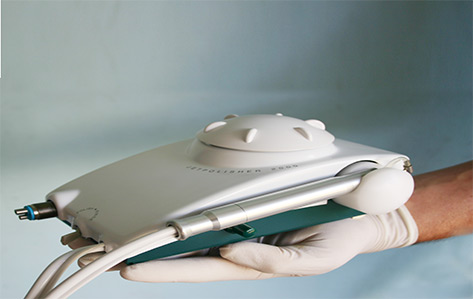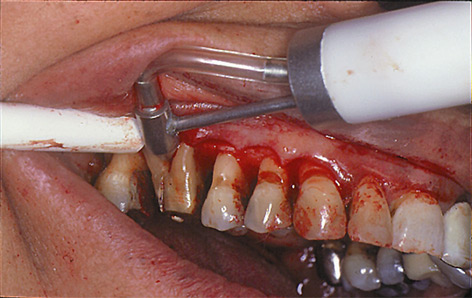


An advance in adhesive dentistry has resulted in sandblasting, to increases micro-retention, being performed as a routine procedure. Instead of wearing a path from the patient’s chair to the office lab to clean excess cement from a patient’s temporary or loosened permanent crown ,or for sandblasting the fitting surface of a crown, bridge inlay or veneer, the procedure is a half- turn away, thanks to the new breed of sandblasters and hookup options. The uninterrupted patient/doctor exchange is especially beneficial with anxious adult patients – no need to cut the reassuring golf story short for a trip down the hall, leaving the patient alone. Standard hookup kits allow, with a simple male disconnect, access to the dental unit’s air source through the female port. Many dentists have sandblasters with quick disconnects in every operatory, and these space- efficient wonders tuck easily into a drawer. The Deldent MiniBlaster ® even boast adaptors for standard 4-hole handpiece ports,or even for your favorite Kavo®, Sirona® or W&H® High speed handpiece port, for a blasting procedure – just pop on the adaptor and activate the sandblaster with your regular foot control, And how about the air quality?
The old dust collection methods are fast disappearing as dentists perform more and more chairside sandblasting. You’ve heard of them as the homemade variety, consisting of a discarded packaging box of gallon plastic milk carton with three handcuts holes. Learning over the nearest trash can, much to the dismay of office staff, Best of all, throwing open a window and blasting away (weather permitting). Times have changed and the new waves of dust collectors not only keep the air clean, but they look great, too – they’re high-tech looking, lightweight and simple to operate and empty. No fancy installation, either- they simply plug into the nearest outlet. Best of all, the new breed of dust collectors are scaled to fit comfortably on an operatory countertop without without getting in the way, and without compromising user comfort or efficiency. They’re designed with clean, pleasing lines to fit into today’s contemporary dental office design and decor. Call your dealer today for a great deal on the Deldent MiniBlaster® clinical sandblaster and DUST- INN ® dust containing units for your practice.

By: Gutmann, Marylou Everett Publication: Journal of Dental Hygiene Date: Monday, June 22 1998
“Oral health care professionals have a responsibility to patients to engage in life-long learning in order to provide the most contemporary clinical care. This review of air polishing should enable clinicians to make sound decisions regarding the most appropriate treatment for each patient. Air polishing has been studied extensively and, when used appropriately, provides a safe, efficient and contemporary approach to achieving a variety of treatment goals”.
Introduction
Air polishing was first introduced to the dental community in the late 1970s as a mechanism to quickly and easily remove extrinsic stain and soft deposits from tooth surfaces. Since that time, researchers have investigated various aspects of this polishing device. Areas of research have included efficiency and effectiveness, effects on hard and soft tissues and restorations, alternative uses, and safety of both the patient and the clinician.
Despite continuing research support for its use since being introduced, the air polisher has not been widely used. White and Hoffman surveyed 2,400 dental hygienists and only 22 percent reported using it routinely.[1] Use of air polishers decreased as the clinician’s age and experience increased.[1] Curricula in many dental hygiene schools do not include clinical instruction in the use of this polishing device due to inadequate numbers of units and difficulty in moving units between clinic stations.[2] Inadequate or insufficient knowledge and experience, therefore, appears to be a major
factor in the underutilization of the air polisher. In an attempt to provide a suitable knowledge base for practicing dental hygienists, the primary purpose of this article is to provide a comprehensive summary and critique of the research on all aspects of air polishing. In addition, a suggested technique, common concerns, and possible solutions will be discussed.
Discussions are based on a review of the relevant literature on air polishing. Tables organize the data into categories to facilitate access of needed information. Because of the various research designs employed and the number of variables that must be controlled, comparative analyses of the studies are difficult. However, where possible, analyses of the validity and reliability of the studies are provided. It should be remembered that while laboratory (in vitro) investigations are useful, the most definitive conclusions must be obtained through clinical (in vivo) studies. Case reports or opinion articles have limited applications. Therefore, interpretation and application of research results must be done with caution.
Effectiveness and Efficiency
Air polishing has been compared to scaling and rubber-cup polishing for efficiency and effectiveness of stain and plaque removal. The literature overwhelmingly supports the use of the air polisher as an efficient and effective means of removing extrinsic stain and plaque from tooth surfaces (Table I).[3-8] Air polishing requires less time than traditional polishing methods and removes stain three times as fast as scaling with comers.[3,7] In addition, less fatigue to the operator has been mentioned as an important benefit of air polishing.[3]

Indispensible in the Orthodontic Office
Airpolishing units are used routinely in general dental practice for plaque and stain removal and for every situation when enamel is cleaned, such as prior to bonding procedures. For example, Scott and Greer ( J.P.Dent 1987 ) found airpolishing to be the most effective, prior to fissure sealant application.
Following a paper by Gerbo, Barnes and Leinfelder (AJODO 1993 } the use of airpolishing is routinely taught in dental hygiene programs as a method of choice for cleansing the tooth surface.
Airpolishing is the method of choice for cleaning the enamel prior to bracket placement..
It has been shown to cause less damage to the enamel surface than the pumice and rubber cup technique ( Willmann et al JADA 1980) In addition, Sodium Bicarbonate is soluble and
easily and completely washed away, Pumice is not- micron particles can be retained in the enamel grooves, and interfere with the bonding.
Rapid and simple plaque and debris removal allows the orthodontist to work in a clean esthetic field. The remnants of recent meals or in-between snacks need no longer waste valuable chairside time. No need to set up a hygiene appointment, a few moments with the Jetpolisher 2000 is all that it takes to clean the field.
Barnes et al. found that airpolishing was the most effective method of plaque removal for orthodontic patients, providing excellent access without damage to the orthodontic appliance. Frequent cleaning with an airpolisher resulted in a greater reduction in gingival bleeding and marginal redness compared with the pumice and rubber cup technique. This was attributed to the more thorough removal of plaque. It is virtually impossible to adequately clean around fixed appliances using a rubber cup technique. The Jetpolisher 2000 is an invaluable aid in the prevention of enamel decalcification around orthodontic appliances
The Jetpolisher 2000 makes light work of clean up following debanding procedures. A few minutes with the Jetpolisher 2000 will remove all the residual stain. At follow-up appointments after debanding, some additional staining is sometimes seen, the Jetpolisher 2000 is close at hand to deal with this.
The Jetpolisher 2000 incorporates the unique HST ™ Homogeneous Stream Technology Polishing system. In this system:
The Deldent Miniblaster™ is being recognized as an indispensable chairside tool in the orthodontic practice. Among its applications are the following:
Not uncommonly, an orthodontic bracket may be dislodged from the tooth during orthodontic treatment. If this occurs, the choice is either to replace it with a new bracket (additional cost of bracket) or if available, to recycle the bracket by means of a recycling technique.
Sandblasting of the mesh of the bracket will completely remove old existing composite and will enable the same bracket with a superior sandblasted surface to be rebonded in the same patients mouth immediately. The total procedure takes only a few moments and a few cases will quickly cover the cost of the unit, in time and convenience, as well as a saving in cost of additional brackets.
Molar bands may come loose during treatment . In most cases, it is the bond between the adhesive cement and the band that has failed, the adhesive to tooth junction often remaining intact. Prior sandblasting of the inner surface of the bands, especially in critical situations, such as with a rapid palatal expansion appliance, can significantly reduce this occurrence.
Bands that come loose should be sandblasted. This will remove old cement and prepare the band surface for re-cementation.
Simple retainers (e.g. lingual cuspid to cuspid retainers) can be fabricated and bonded to the teeth, after sandblasting the bonding areas of the adapted wire (Zachrisson JCO 1995)
Bonding can be more difficult in the adult patient where a great variety of restorations may be encountered, that cannot be bonded to, with routine bonding protocols, as is the case when bonding to the natural teeth. These include crown and bridgework and restorations of various materials; amalgam, composite, porcelain and precious metals.
Effective bonding to artificial surfaces has been facilitated by new techniques and materials but mechanical retention is an important ally to all bonding techniques
Roughening a surface with burs or stones may create the appearance of roughness due to the periodic grooves and ridges but little micro-mechanical retention is achieved.( Edel A.and Edel J. Ind Dent. 1998)
The Deldent Miniblaster strips away contaminants and a microscopic layer of metal, composite or porcelain depending on the material being blasted, creating a retentive surface with a miryad of microscopic undercuts. This increased surface roughness significantly enhances bond strength.
The Deldent Miniblaster has been approved by the FDA for intra-oral use to enhance bonding and its additional clinical applications are only limited by the imagination of the operator.
The DUST INN 2000™ Compact Esthetic Dust Collector is an excellent companion to the Miniblaster. It is designed for use with all Miniblasters or Microetchers and for chairside grinding procedures.
It has excellent all round visibility and features an efficient 12 volt filtered extraction system that is quiet, and by creating a negative pressure that efficiently contains the abrasive particles in the unit and not in the operatory.
No need to trip down the hall to the lab. Now, everything is conveniently available just a half turn away, thanks to this esthetic and practical device which is nice enough to let your patients see. This is especially beneficial when treating anxious youngsters, and allows you to maintain the uninterrupted patient/doctor exchange that is so important.
The Dust-Inn is a high-style contemporary unit that not only fits well into the clean, sleek design of modern dental décor, but eliminates the need for accessory lighting, due to the transparent dome that provides all-round visibility. Best of all the Dust-Inn is scaled to fit on an operatory countertop without getting in the way.